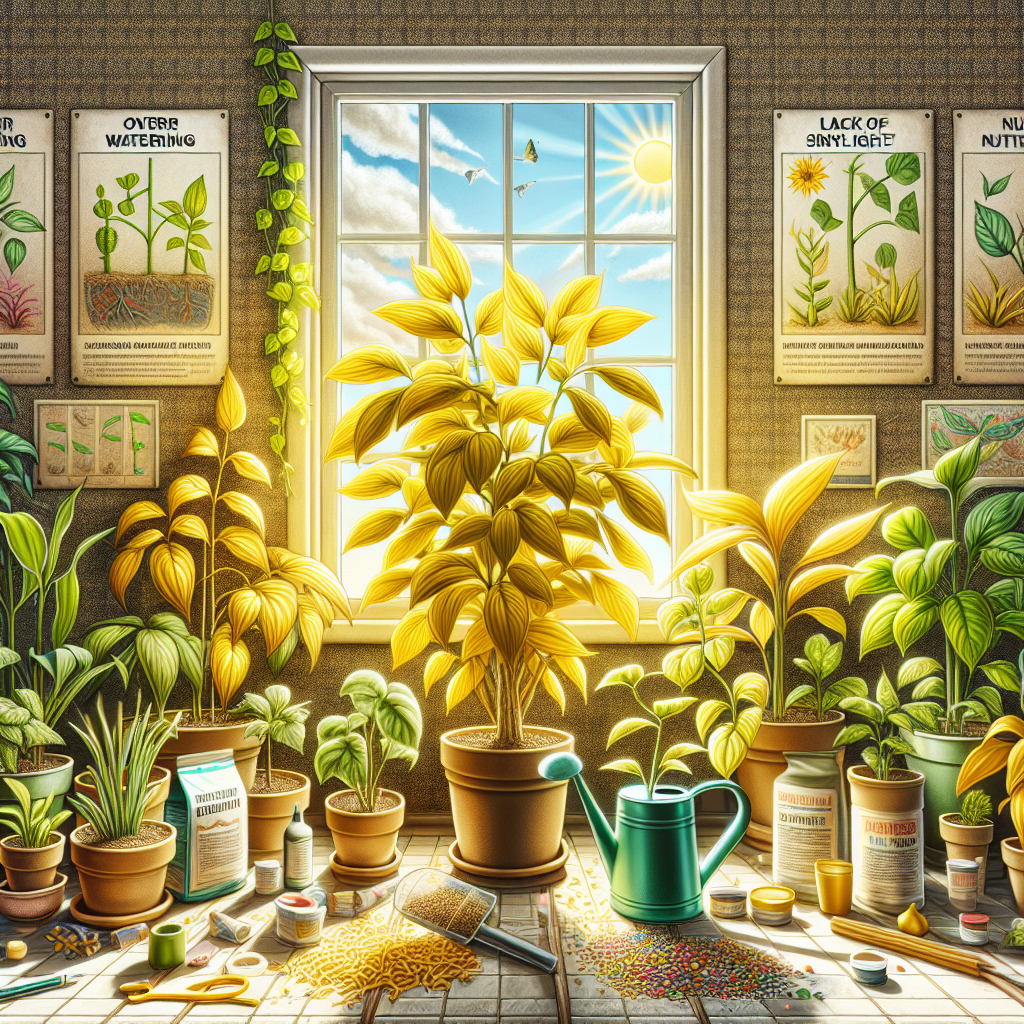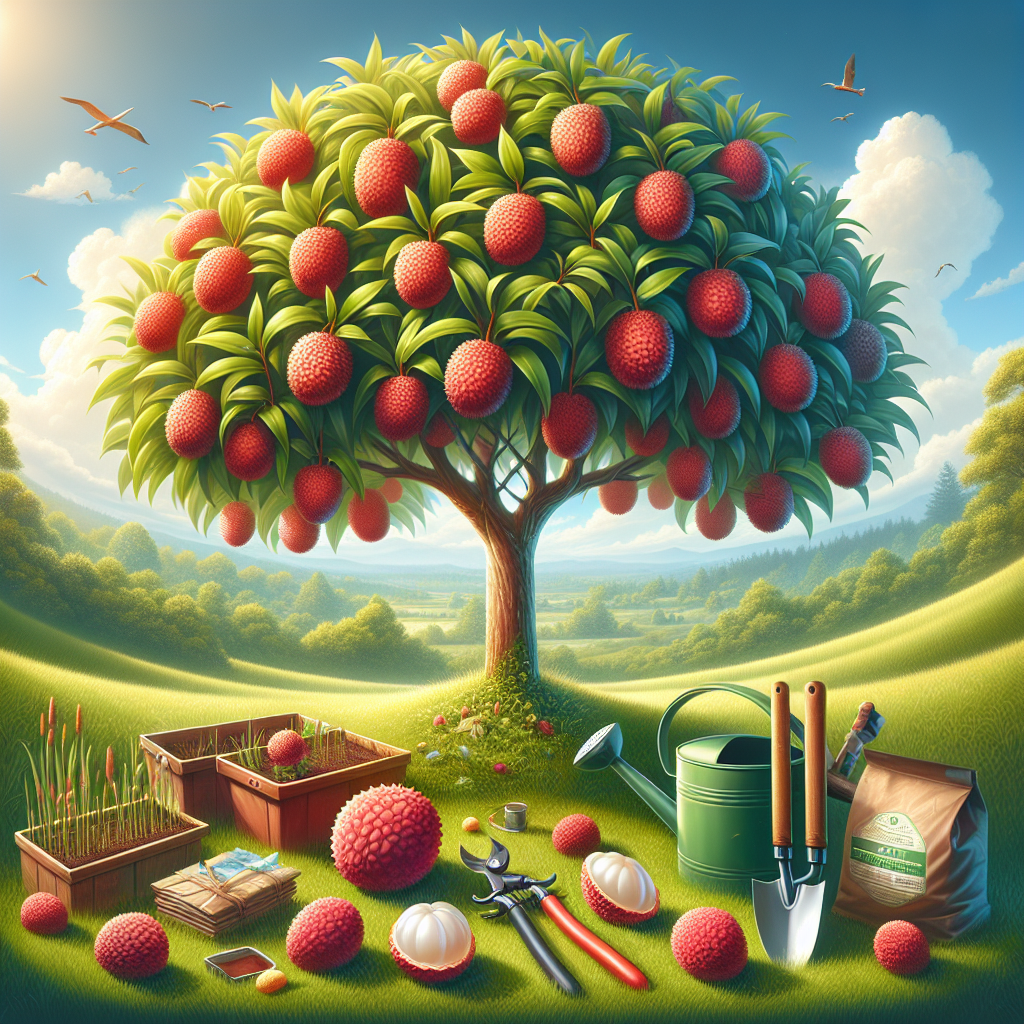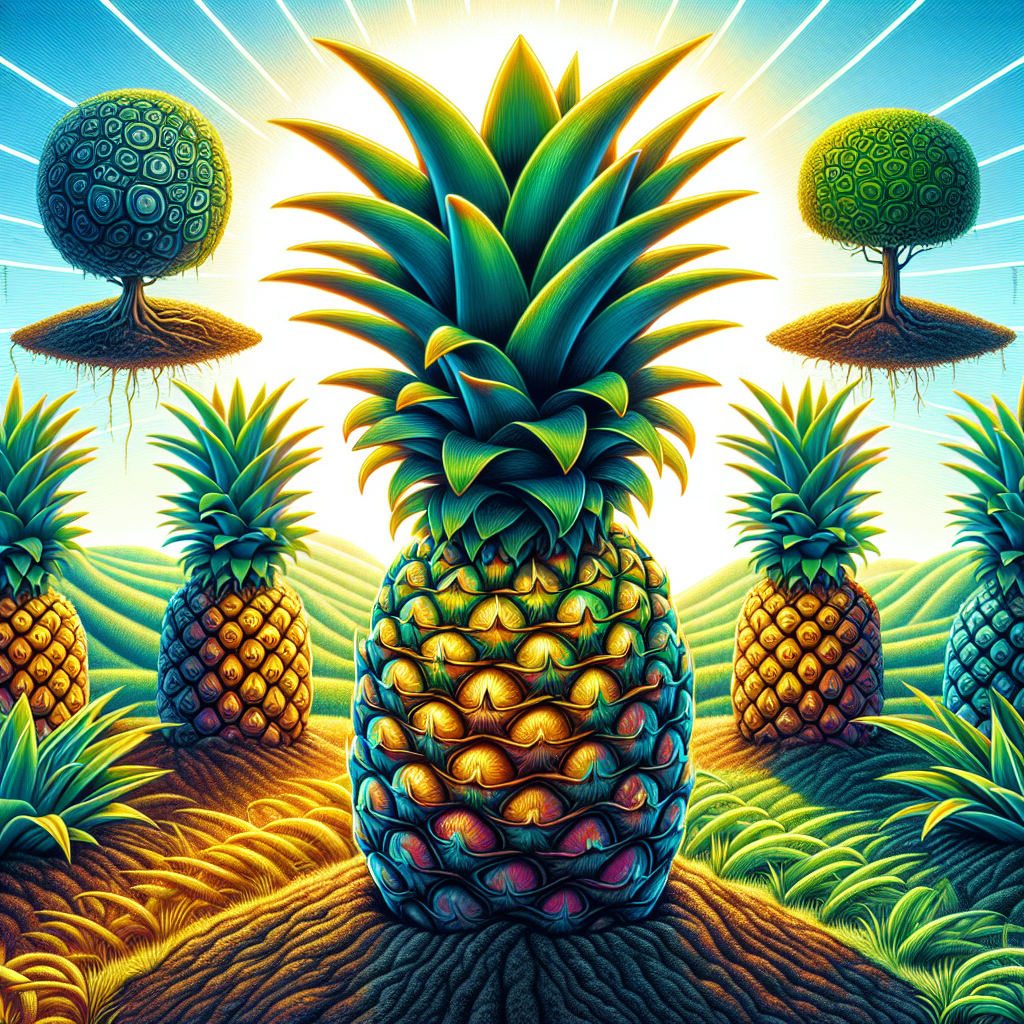Yellowing Leaves on Houseplants: Causes and Solutions
Updated May 26, 2024 at 5:59 pm

Understanding Yellowing Leaves on Houseplants: An Overview
-
Pet Friendly:
Many houseplants are safe for pets, but some can be toxic. When tackling yellowing leaves, ensure the plants you choose are non-toxic to your furry friends.
Light Requirements:
Different plants require varying levels of light. Consider if your plant’s yellowing leaves could be due to too much or too little light exposure.
Watering:
Watering practices significantly affect plant health. Yellow leaves often signal overwatering or underwatering issues.
Humidity:
Houseplants have specific humidity needs. Low humidity can cause leaf yellowing, especially in tropical varieties.
Temperature:
Extreme temperatures can stress plants, leading to yellowing leaves. Maintaining a steady, appropriate temperature is key.
Difficulty:
Some plants are more forgiving than others. If you’re new to plant care, select varieties that are less prone to yellowing and easier to maintain.
What Causes Yellowing Leaves on Houseplants?
Experiencing yellow leaves on your indoor plants can be disheartening, especially when you’re not sure of the cause. It could be due to a range of issues from natural aging to more serious problems that could threaten the plant’s survival. Let’s touch on some common causes, and throughout our discussion, I’ll introduce you to products that can help address each issue.
Watering Issues: Overwatering or Underwatering?
It’s said that often the most common reason behind yellow leaves is improper watering. Both overwatering and underwatering can lead to yellow leaves, but they cause very different symptoms. Overwatering can lead to root rot, an issue where the roots can’t access the oxygen they need due to excess water in the soil. Plants with root rot will have soft yellow leaves and may also exhibit a moldy smell.
Underwatering, on the other hand, will cause leaves to dry out and turn yellow from the edges inward. The soil will be dry to the touch, and leaves may feel crispy. A moisture meter, like the Dr.meter Soil Moisture Sensor, can be an incredible tool to help prevent both overwatering and underwatering. According to reviews, the Dr.meter device provides accurate moisture readings helping many plant enthusiasts keep their soil moisture at the perfect level for their plants. The tool is simple to use: just insert it into the soil and read the moisture level. The user-friendly interface makes it ideal for any plant owner, newcomer or seasoned green thumb alike.
Find This and More on Amazon
Light Levels: Too Much or Too Little?
Yellow leaves might also indicate that your plant is either getting too much sun or not enough. Plants that are getting scorched by too much direct sunlight will have yellow leaves with brown, crispy tips. On the other hand, plants not getting enough light will have leaves that look faded and turn yellow because they’re unable to photosynthesize properly.
Using a light meter can help you determine if your plant is getting the appropriate amount of light. The Gain Express Soil Ph & Light Meter not only measures moisture but also provides light reading, making it a versatile tool. Reviews have highlighted its reliability and the extra benefit of helping users find just the right location in their home that receives optimal light for specific plant types.
Find This and More on Amazon
Nutrient Deficiencies or Overfertilization?
Your plants might also be telling you that they’re not getting the nutrients they need, or perhaps, they are getting too much. Nitrogen deficiency can cause older leaves to yellow, whereas a lack of iron usually affects younger leaves first. On the flip side, too much fertilizer can burn the roots, leading to yellowing leaves.
A soil test kit can be invaluable for diagnosing these issues. The MySoil- Soil Test Kit is one such product that enables you to check for vital nutrient levels as well as soil pH, which can significantly affect a plant’s ability to absorb nutrients. According to several reviews, the MySoil test kit has guided users to amend their soil correctly and reverse the yellowing of leaves on their houseplants. The straightforward instructions and actionable insights provided in the results are frequently praised.
Find This and More on Amazon
Environmental Stress and Pest Infestation
Environmental stress such as sudden changes in temperature, drafts, and humidity fluctuations can lead to leaf yellowing. Similarly, pests such as spider mites, mealybugs, and aphids suck the sap from leaves, causing them to turn yellow and drop. This happens as the plant’s circulatory system is interrupted by these tiny vampires, and toxins may also be introduced which further harm the plant.
An all-purpose organic insecticide like Bonide Neem Oil can be a lifesaver when dealing with pests. This product is often recommended in reviews due to its effectiveness against a wide range of common houseplant pests while being safe for the plant and the environment when used as directed. Reviewers have noted it works well with regular application and can help restore plant health, getting rid of those yellow leaves due to pest problems.
Find This and More on Amazon
How to Prevent Yellow Leaves on Your Houseplants?
The best defense against yellow leaves is prevention. Knowing your plant’s specific care requirements and monitoring for the early signs of stress will help keep your indoor garden thriving. Establish a routine that includes checking the soil moisture, ensuring the plant is getting the right amount of light, and being watchful for pests are all part of a good prevention plan.
Optimal Watering Practices
To avoid watering issues, make sure you understand each plant’s unique needs. Some plants prefer to dry out between waterings, while others like consistently moist soil. Always check the soil before watering; a simple finger test can tell you if the top inch of soil is dry, which is a common indicator it’s time to water for many plants.
Providing the Right Amount of Light
Adjusting your plant’s exposure to light can sometimes be as simple as moving it closer to or further away from a window, or even rotating it for even light distribution. If you don’t have enough natural light, consider investing in grow lights. They come in various sizes and shapes to fit all sorts of indoor gardening setups.
Nutrient Balancing with Fertilizer
Using a balanced, water-soluble fertilizer can help prevent nutrient deficiencies. Apply according to the package directions, typically during the growing season and refraining in the dormant winter months unless your specific plant species calls for it. Moderation is key to avoiding overfertilization.
Creating a Stable Environment
Try to keep your plant’s environment as stable as possible. Avoid placing them near drafty windows or doors, heating or cooling vents, and out of direct AC or heat. If your home suffers from dry air, a small humidifier can work wonders for increasing humidity, especially for tropical plants. It’s like giving them a little slice of their native habitat.
Choosing the Right Soil and Repotting
The type of soil you use is essential for the health of your houseplants. Good quality potting soil should be well-draining yet retain enough moisture to prevent the roots from drying out. Yellowing leaves might be the result of compacted or exhausted soil which lacks nutrients or does not provide adequate drainage. It might be time to repot your plant if it’s been in the same soil for a long time.
Repotting is a great opportunity to inspect the root system for any signs of rot or pests. When repotting, selecting the right pot size is also critical – too large, and the soil can retain too much water, too small, and your plant might become root-bound.
When it comes to high-quality potting mixes, FoxFarm Ocean Forest Potting Soil is a product that comes highly recommended in gardening circles. It is known for its well-aerated texture, pH adjusted nature, and a mix of earthworm castings, bat guano, and sea-going fish and crab meal. The reviews often mention how it invigorates plants and provides them with nutrients that are both fast-acting and slow-release. People appreciate that while it’s rich, it doesn’t leave soil feeling soggy – which can help prevent those troubling yellow leaves.
Find This and More on Amazon
Regular Monitoring and Maintenance
Regular observation is key to maintaining plant health and preventing yellow leaves. Check your plants regularly for any signs of distress, such as discoloration, spotting, or wilting. Early detection often means a better chance of successfully treating any issues.
Clean your plants too. Dust can block sunlight and reduce a plant’s ability to photosynthesize. Use a damp cloth to gently wipe leaves. Also, pruning dead or yellowing leaves can help the plant focus its energy on new growth and maintain a better appearance.
When to Consult a Professional or a Community
Even with the best care, sometimes plants will develop problems that are hard to diagnose. Don’t be afraid to reach out to your local nursery, an online community, or a professional plant doctor for help. They can offer you advice tailored to your specific situation.
For example, if you’re noticing a pest problem you can’t handle, products like Bonide Systemic Insect Control could be recommended by a professional. It is often cited in reviews for being effective for indoor plant pest control, while being easy to apply. It’s designed to protect the plant from the inside out, meaning less maintenance for you. Reviewers appreciate that it can be used sparingly, minimizing the impact on the plant and the surrounding environment.
Find This and More on Amazon
Introducing Beneficial Organisms
One innovative way to address pests and nutrient issues in houseplants is to introduce beneficial organisms into your plants’ ecosystem. Organisms like beneficial nematodes or ladybugs can keep pest populations in check, and mycorrhizal fungi can help plants absorb nutrients more effectively.
Products such as Nature’s Good Guys Beneficial Nematodes have been well-received by plant enthusiasts. The reviews often note that they are easy to apply and effective for controlling a wide range of soil-born pests without the use of harsh chemicals.
Evaluating the Plant’s Overall Health
A yellowing leaf can sometimes be a sign of a larger problem, but it also might be a natural part of the plant’s life cycle. Older leaves will sometimes naturally yellow and drop off as they age. Evaluating the plant’s overall vitality – its growth rate, the appearance of new foliage, and the firmness of the stem – can help in determining whether yellow leaves are a cause for concern.
By combining all these practices – choosing the right soil, monitoring water and light levels, addressing pests and diseases promptly, and considering your plant’s specific needs – you can often prevent yellowing leaves and keep your houseplants healthy and vibrant. If you’ve gone down the list and checked off all the boxes, but you’re still struggling, remember that patience is key and sometimes plants just need a little extra time to bounce back from stressors.
Summary: Reviving Your Yellowing Houseplants
In summary, yellowing leaves on houseplants can be due to a variety of reasons – some simple to fix, others more complex. By understanding the potential causes, you can take the necessary steps to prevent and treat this common issue. With a bit of patience and the right approach, you can often bring your beloved houseplants back to their full green glory.
Remember, plant care is as much of an art as it is a science. Every plant is different, and what works for one might not work for another. Stay observant, be persistent, and don’t be afraid to try new methods or products that could help your plants thrive. With these tips and a little care, you can create a lush indoor garden that will be the envy of all your plant-loving friends.
Embracing the Joy of Houseplant Parenthood
Caring for houseplants shouldn’t feel like a chore or a source of stress. It’s a chance to bring a slice of nature into your home and create a space that feels lively and rejuvenating. So if you’re glimpsing a few yellow leaves, take it as an opportunity to get to know your green companions better, adjust your care routine, and learn something new. Remember, every plant parent faces this issue at some point, and it’s all part of the rewarding journey towards a thriving indoor oasis.
Think of your plants as silent communicators. Each change in leaf color, texture, or form is like a message. Your job is to decode it and figure out what your plants are trying to tell you. Perhaps they require a different spot with better lighting, or maybe they’re just asking for a bit less water. Listening to these subtle cues will make you a more intuitive and successful plant caregiver.
Ultimately, yellowing leaves on houseplants is a problem you might encounter. But with a bit of knowledge, the right tools, and some attention, it’s a problem that comes with a solution. So take a deep breath, assess the situation, and get ready to help your houseplants flourish. Before you know it, your green friends will be thriving again, ready to brighten your home and purify your air.
And who knows? As you nurture your plants back to health, you might find yourself growing too – in patience, attentiveness, and the simple joy that comes with caring for living things. So embrace the challenges of houseplant care as part of the rewarding journey of green companionship in your home.
Joining the Community of Plant Lovers
You’re not alone in your quest for lush foliage and vibrant plants. There’s a whole community of plant enthusiasts out there, ready to share their experiences, tips, and support. Join online forums, follow plant care blogs, and connect with local gardening clubs to expand your knowledge and share the joy of growing houseplants. When in doubt, these communities can offer advice, support you through your plant care journey, or simply cheer on your successes as your houseplants flourish.
Above all, remember that plant care is a journey. There will be ups and downs, but each experience brings you closer to becoming an expert in your own right. Just like people, plants need time and consistent care to show their best selves. With the solutions we’ve discussed, your yellowing houseplants have a fighting chance, and you have the opportunity to become the plant-loving hero they need. So roll up your sleeves, arm yourself with the best tools and products, and get ready to give your houseplants the vibrant life they deserve.
Unlocking the Green Thumb Within
With careful observation, a bit of research, and some trial and error, anyone can develop a green thumb. Yellowing leaves on houseplants are just one of the many challenges you will face and overcome. Whether you have a single plant on your windowsill or a full indoor jungle, the lessons you learn from each experience will only enhance your skills and deepen your enjoyment of this wonderful hobby.
Remember, there’s no magic bullet for perfect plant health, but with the knowledge and tools we’ve discussed, you’re well on your way to creating and maintaining a lush, green sanctuary in your own home. Your dedication and love for your plants are the most crucial ingredients in the recipe for their success. So keep learning, keep growing, and cherish every step on your journey to becoming an adept plant caretaker. Here’s to healthy plants and happy plant parenting!
Shop more on Amazon

